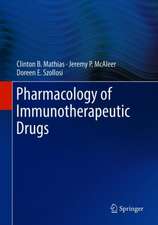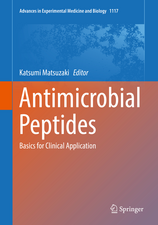Pharmacokinetics of Drugs: Handbook of Experimental Pharmacology, cartea 110
Editat de Peter G. Welling Cuvânt înainte de J.G. Wagner Contribuţii de G.L. Amidon Editat de Luc P. Balant Contribuţii de J.P.F. Bai, L.P. Balant, C.M. Barksdale, I.A. Blair, D.D. Breimer, M. Chiba, J. Delforge, M. Eichelbaum, B.L. Ferraiolo, A.J. Fischman, M. Gex-Fabry, N. Holford, J. Kantrowitz, H.K. Kroemer, T.M. Ludden, J.M. Mayer, B. Maziere, C. McMartin, G. Minkus, M.A. Mohler, G.D. Nordblom, R. O'Neill, K.S. Pang, O. Pelkonen, A. Racine-Poon, R.H. Rubin, J.-L. Steimer, B.H. Stewart, H.W. Strauss, B. Testa, S. Vozeh, P.G. Welling, R.G. Wills, A. Yacobien Limba Engleză Paperback – 23 dec 2011
Din seria Handbook of Experimental Pharmacology
- 5%
 Preț: 3517.78 lei
Preț: 3517.78 lei - 5%
 Preț: 1425.97 lei
Preț: 1425.97 lei - 5%
 Preț: 1435.28 lei
Preț: 1435.28 lei - 5%
 Preț: 1430.52 lei
Preț: 1430.52 lei - 5%
 Preț: 1930.69 lei
Preț: 1930.69 lei - 5%
 Preț: 1922.47 lei
Preț: 1922.47 lei - 5%
 Preț: 1937.46 lei
Preț: 1937.46 lei - 5%
 Preț: 2117.58 lei
Preț: 2117.58 lei - 5%
 Preț: 2119.96 lei
Preț: 2119.96 lei - 5%
 Preț: 2117.38 lei
Preț: 2117.38 lei - 5%
 Preț: 1088.17 lei
Preț: 1088.17 lei - 5%
 Preț: 1098.27 lei
Preț: 1098.27 lei - 5%
 Preț: 1420.29 lei
Preț: 1420.29 lei - 5%
 Preț: 1104.84 lei
Preț: 1104.84 lei - 5%
 Preț: 1104.84 lei
Preț: 1104.84 lei - 5%
 Preț: 1108.14 lei
Preț: 1108.14 lei - 5%
 Preț: 1106.69 lei
Preț: 1106.69 lei - 5%
 Preț: 1105.77 lei
Preț: 1105.77 lei - 5%
 Preț: 1174.35 lei
Preț: 1174.35 lei - 5%
 Preț: 1432.50 lei
Preț: 1432.50 lei - 5%
 Preț: 408.48 lei
Preț: 408.48 lei - 5%
 Preț: 409.63 lei
Preț: 409.63 lei - 5%
 Preț: 539.90 lei
Preț: 539.90 lei - 5%
 Preț: 720.47 lei
Preț: 720.47 lei - 5%
 Preț: 733.09 lei
Preț: 733.09 lei - 5%
 Preț: 731.27 lei
Preț: 731.27 lei - 5%
 Preț: 746.43 lei
Preț: 746.43 lei - 5%
 Preț: 747.72 lei
Preț: 747.72 lei - 5%
 Preț: 725.24 lei
Preț: 725.24 lei - 5%
 Preț: 742.80 lei
Preț: 742.80 lei - 5%
 Preț: 393.23 lei
Preț: 393.23 lei - 5%
 Preț: 735.66 lei
Preț: 735.66 lei - 5%
 Preț: 728.33 lei
Preț: 728.33 lei - 5%
 Preț: 389.52 lei
Preț: 389.52 lei - 5%
 Preț: 740.58 lei
Preț: 740.58 lei - 5%
 Preț: 730.19 lei
Preț: 730.19 lei - 5%
 Preț: 723.42 lei
Preț: 723.42 lei - 5%
 Preț: 731.27 lei
Preț: 731.27 lei - 5%
 Preț: 726.68 lei
Preț: 726.68 lei - 5%
 Preț: 3516.49 lei
Preț: 3516.49 lei - 5%
 Preț: 729.26 lei
Preț: 729.26 lei - 5%
 Preț: 737.11 lei
Preț: 737.11 lei - 5%
 Preț: 730.92 lei
Preț: 730.92 lei - 5%
 Preț: 738.78 lei
Preț: 738.78 lei - 5%
 Preț: 909.94 lei
Preț: 909.94 lei - 5%
 Preț: 720.10 lei
Preț: 720.10 lei - 5%
 Preț: 734.74 lei
Preț: 734.74 lei - 5%
 Preț: 727.80 lei
Preț: 727.80 lei
Preț: 730.71 lei
Preț vechi: 769.17 lei
-5% Nou
Puncte Express: 1096
Preț estimativ în valută:
139.83€ • 149.52$ • 116.58£
139.83€ • 149.52$ • 116.58£
Carte tipărită la comandă
Livrare economică 17 aprilie-01 mai
Preluare comenzi: 021 569.72.76
Specificații
ISBN-13: 9783642786822
ISBN-10: 3642786820
Pagini: 568
Ilustrații: XXVI, 537 p.
Dimensiuni: 155 x 235 x 30 mm
Greutate: 0.79 kg
Ediția:Softcover reprint of the original 1st ed. 1994
Editura: Springer Berlin, Heidelberg
Colecția Springer
Seria Handbook of Experimental Pharmacology
Locul publicării:Berlin, Heidelberg, Germany
ISBN-10: 3642786820
Pagini: 568
Ilustrații: XXVI, 537 p.
Dimensiuni: 155 x 235 x 30 mm
Greutate: 0.79 kg
Ediția:Softcover reprint of the original 1st ed. 1994
Editura: Springer Berlin, Heidelberg
Colecția Springer
Seria Handbook of Experimental Pharmacology
Locul publicării:Berlin, Heidelberg, Germany
Public țintă
ResearchCuprins
A. Introduction.- 1 Role of Pharmacokinetics in Drug Discovery and Development.- B. Analytical Methods.- 2 Contemporary Aspects of Radioimmunoassay Development for Drug Analysis.- 3 Mass Spectrometry in Drug Disposition and Pharmacokinetics.- 4 Analytical Methods for Biotechnology Products.- C. In Vitro Methods-Protein and Tissue Binding.- 5 Metabolism: Scaling-up from In Vitro to Organ and Whole Body.- 6 Gastrointestinal Transport of Peptide and Protein Drugs and Prodrugs.- D. Classical Problems.- 7 Stereoselectivity in Metabolic Reactions of Toxication and Detoxication.- 8 Interethnic Differences in Drug Disposition and Response: Relevance for Drug Development, Licensing, and Registration.- 9 Clinical Relevance of Pharmacogenetics.- 10 Role of Environmental Factors in the Pharmacokinetics of Drugs: Considerations with Respect to Animal Models, P-450 Enzymes, and Probe Drugs.- 11 Time Course of Drug Effect.- E. Future Trends in Pharmacokinetics.- 12 Biotechnology Products.- 13 Peptide and Protein Drugs.- 14 Toxicokinetics.- 15 The Population Approach: Rationale, Methods, and Applications in Clinical Pharmacology and Drug Development.- F. Impact of New Methods on Pharmacokinetics.- 16 Contribution of Positron Emission Tomography to Pharmacokinetic Studies.- 17 In Vivo Imaging in Drug Discovery and Design.- G. Appendix.- 18 Considerations on Data Analysis Using Computer Methods and Currently Available Software for Personal Computers.


























